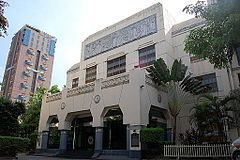Address Leon Guinto Street Completed 1894 Opened 1894 Renovated 1957 | Structural engineer Ramon del Rosario Architect Andrés Luna de San Pedro | |
 | ||
Civil engineer Pedro Siochi y Angeles (1886-1951) who is a native of Malabon, Rizal and graduated with a degree in Civil Engineering from the University of Ghent, Belgium Main contractor the Pedro Siochi and Company Similar Manila Zoo, Manila Ocean Park, Manila Cathedral, Fort Santiago, Baroque Churches of the Phil | ||
Saint cecilia s hall top 12 facts
The Conservatory of Music of St. Scholastica's College Manila was founded in 1907 by Sister Baptista Battig OSB, herself a noted concert pianist. In 1932 with the growing popularity of concert music in Manila, Philippines, St. Scholastica's College built a concert hall and named it St. Cecilia's Hall. It was built under the supervision of the renowned engineering firm Pedro Siochi and Company. The hall was named after the patron saint of music and musicians, and soon become the venue of numerous recitals and concerts featuring pianists from St. Scholastica's College-Manila. St. Cecilia's Hall host not only their student's performance venue needs but also Manila's growing social calendar. The forerunner to the Cultural Center of the Philippines, St. Cecilia's Hall was designed by a notable Filipino architect, Andres Luna de San Pedro in the Egyptian Art Deco style.
In 1945, St. Cecilia's Hall was almost completely damaged by the American forces during the Liberation of Manila. Nine years later, reconstruction started under the supervision of Architect Roberto Novenario and Engineer Ramon del Rosario. In 1955, St. Cecilia's Hall reopened and soon assumed the premier concert venue in Manila, with famous mucisian both Filipino and Foreign performers performing on its stage. With the emergence of performing arts on St. Scholastica's campus, it was also the setting of many concerts, plays, pageants and oratorical contests. In the latter years, with the opening of bigger performing arts venue, soon St. Cecilia's Hall become confined purely to school affairs. In 1998, St. Cecilia's Hall again underwent extensive renovation and reopened in July 16, 2000. A year into its renovation, the National Historical Institute (today National Historical Commission of the Philippines) declared the St. Cecilia's Hall as a National Cultural Landmark, underscoring its importance and contributions in the cultural development of the country.
